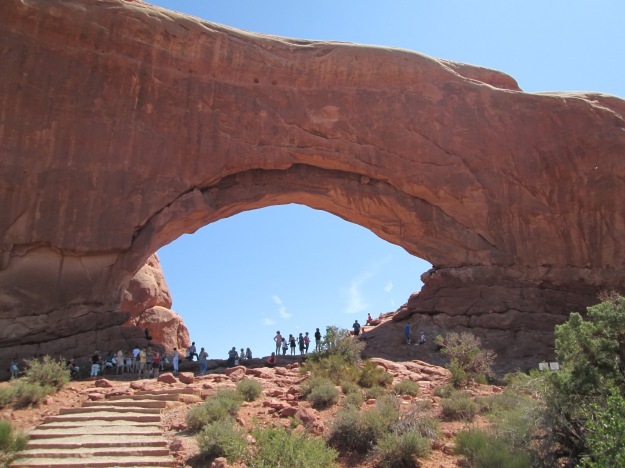I have a guest post up today on StigmaFighters.com,
a site devoted to ending the societal stigma of mental illness by
telling the stories of real people who live with mental disorders. I
myself am fortunate enough not to be a victim of one of these
conditions. But as I point out in my post, you don't have to be mentally
ill to suffer the stigma associated with mental illness.
Pages
- HOME
- ABOUT
- ON HEARING OF MY MOTHER'S DEATH SIX YEARS AFTER IT HAPPENED
- STORIES FROM MY MEMORY-SHELF
- TO ALL THE PENISES I'VE EVER KNOWN
- THE HANNELACK FANNY, OR HOW I LEARNED TO STOP WORR...
- JUST THE THREE OF US
- MY LIFE WITH MICHAEL: A NOVEL OF SEX, BEER, AND MIDDLE AGE
- WORKS IN PROGRESS
- PUBLICATIONS
- THINGS THAT MAKE ME SMILE
- THE LONG ROAD HOME
Subscribe to my newsletter!
Sunday, August 31, 2014
With a Name Like Badlands, It Has to Be Good!
Join me, if you will, on a journey through one of the most forbidding destinations in the Great Plains. But I warn you - there's danger in them thar hills, dire and perhaps deadly danger!
Unless, of course, you're driving around comfortably in your car, as I was. Just play along, people!
Upon entering the park south of Wall, South Dakota, your first view is of this, the Pinnacles formation. It's hard to convey in a single photograph just how massive this is - these formations literally go on for as far as the eye can see. How daunting it must have been to early settlers of the region, not knowing when - or if - the Badlands would ever end.

The soil colors are caused by the decomposition of different plants at various points in the area's geologic history. The layers became fossilized and were thus preserved in the "rainbow" arrangement we see today.
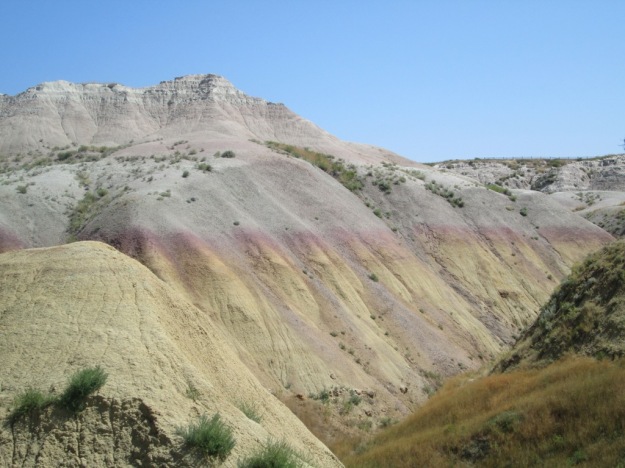
This section almost reminds me of Arizona's Native American cliff dwellings - except that no rational, civilized people would build a home here when they had a nice, comparatively comfortable desert available to them.

There doesn't seem to be much in the way of wildlife here, either, except for insects, and, of course, these lovely fellows.

Notice the teeny little structure up top - then imagine trying to climb your way up the sides of this enormous crevasse.

I'm pretty sure this is what Tolkien had in mind when pictured the land of Mordor. Let's hope Sauron isn't still hanging out in here somewhere.
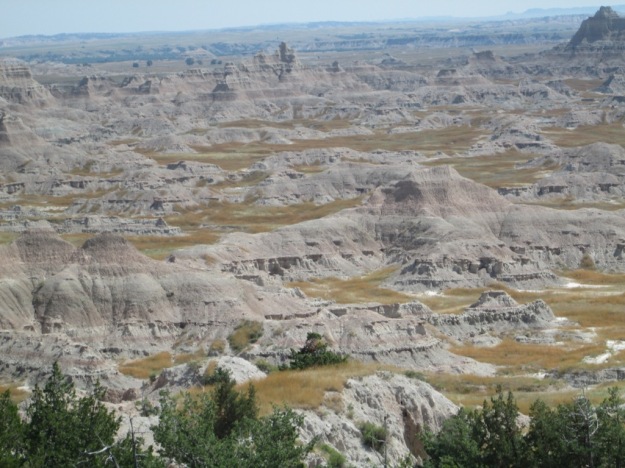
If you would like to see more photos from my cross-country travels, please follow my new Pinterest account at http://www.pinterest.com/lorilschafer/.
For updates on my forthcoming memoir The Long Road Home, which I am drafting during this road trip, please follow my blog or subscribe to my newsletter.
Unless, of course, you're driving around comfortably in your car, as I was. Just play along, people!
Upon entering the park south of Wall, South Dakota, your first view is of this, the Pinnacles formation. It's hard to convey in a single photograph just how massive this is - these formations literally go on for as far as the eye can see. How daunting it must have been to early settlers of the region, not knowing when - or if - the Badlands would ever end.

The soil colors are caused by the decomposition of different plants at various points in the area's geologic history. The layers became fossilized and were thus preserved in the "rainbow" arrangement we see today.

This section almost reminds me of Arizona's Native American cliff dwellings - except that no rational, civilized people would build a home here when they had a nice, comparatively comfortable desert available to them.

There doesn't seem to be much in the way of wildlife here, either, except for insects, and, of course, these lovely fellows.

Notice the teeny little structure up top - then imagine trying to climb your way up the sides of this enormous crevasse.

I'm pretty sure this is what Tolkien had in mind when pictured the land of Mordor. Let's hope Sauron isn't still hanging out in here somewhere.

* * *
For updates on my forthcoming memoir The Long Road Home, which I am drafting during this road trip, please follow my blog or subscribe to my newsletter.
Thursday, August 28, 2014
"Les terres mauvais à traverser" - Badlands National Park
Take a look and see if you can guess why French-Canadian fur trappers called this section of the South Dakota prairie "bad lands to cross."
* * *
If you would like to see more videos from my cross-country travels, please check out my new YouTube channel: https://www.youtube.com/channel/UCb5RugrJMSHh6_4hkgHmkMA.
For updates on my forthcoming memoir The Long Road Home, which I am drafting during this road trip, please follow my blog or subscribe to my newsletter.
* * *
For updates on my forthcoming memoir The Long Road Home, which I am drafting during this road trip, please follow my blog or subscribe to my newsletter.
Wednesday, August 27, 2014
South Dakota - No Place I'd Rather Be
I have been awoken by lightning. Great, powerful flashes of it,
flickering in an asynchronous beat all around me, in every imaginable
rhythm, in every possible direction. It is as if the heavens have
decided to let down their giant disco ball and are twirling it around
the gods’ roller rink in celebration of summer.
I am sleeping in the parking lot of a casino just over the border of South Dakota. Technically I am on Sioux land; the flag flying in the wind by the casino door tells me so.
The sky was threatening to storm, all day, it seemed, not because of storm clouds gathering, or because of darkness overhead, but because of the heaviness in the air. You can feel a thunderstorm brewing long before you can see it. It assails the subconscious long before the senses.
The rain washes in torrents down my truck window. I have to go to the bathroom, but I'll wait. That is the beauty of thunderstorms; what seems to differentiate them from ordinary rainstorms, which can last all day; the way they release their tension, and then travel down the road, to threaten some other town, or some other open prairie. They are like motorists, in that way; you rarely have to wait long for them to pass.
It has been about ten minutes now, and the rain has settled into a drizzle. The lightning flashes have grown fainter, and farther away; the party has moved on to another scene, another venue.
I climb out of the truck and walk down the road a ways to the nearby truck stop. It's warm outside, very warm. It smells wonderful, like fresh rain on fresh grass. It smells like New England. It feels like New England, too; that heat of summer that never seems to let go, even in the night. It clings to your body, your bed, your home. To the earth itself.
It's one of the aspects of the Bay Area to which I’ve never grown accustomed. How cold it is at night, even in summer. It never feels natural to me, the chill that descends in the evening, making you question whether it's really July or August or September. How I’ve missed those warm, sometimes even scorching summer nights. How, even all these years later, I still long for them.
This heat, this midnight warmth speaks to me. The rain speaks to me. The lightning, yes, even the thunder and the lightning speak to me. They speak to me of home, of security, of comfort. My heart – in spite of itself – speaks back.
I am walking back across the parking lot to my truck. I feel as wonderful as the air smells. It is one-thirty in the morning, local time. I have slept for about three hours. I am almost tempted to move on, I feel so awake, so alive now.
But I won’t. I feel at home here, in the back of my truck, in the parking lot of an American Indian casino, in a largely uninhabited portion of South Dakota. It feels natural to me, being here, cuddling up in my little bed and sleeping here. This is where I wanted to be all along. I knew it, without knowing why. I still don’t know why. I only know that it suits my mood. It suits me.
I almost wish I could stay here for a while. I wouldn't mind finding a little place to hole up in, and enjoying the rest of a truly rural, truly traditional – to my mind – summer, while it lasts. There would be plenty for me to do, plenty for me to enjoy. I could sit and watch the rain, then watch the sun dry it up. Sit and smell the grass; smell the rain feeding it, the sun feeding it, too. Let them feed my soul and feed my spirit, the sun and the rain. Let them fill me up, too; let them warm and wet me, watch me revive under their nourishment, watch me grow.
But I know I can't. I shouldn't. I've got to be moving on. While there’s still time.
Here there doesn’t seem to be any time. Only the sun, and the rain, and the never-ending growth of new grass.
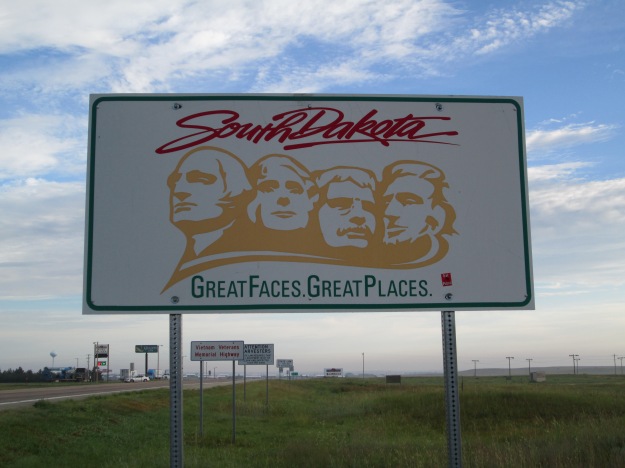
I am sleeping in the parking lot of a casino just over the border of South Dakota. Technically I am on Sioux land; the flag flying in the wind by the casino door tells me so.
The sky was threatening to storm, all day, it seemed, not because of storm clouds gathering, or because of darkness overhead, but because of the heaviness in the air. You can feel a thunderstorm brewing long before you can see it. It assails the subconscious long before the senses.
The rain washes in torrents down my truck window. I have to go to the bathroom, but I'll wait. That is the beauty of thunderstorms; what seems to differentiate them from ordinary rainstorms, which can last all day; the way they release their tension, and then travel down the road, to threaten some other town, or some other open prairie. They are like motorists, in that way; you rarely have to wait long for them to pass.
It has been about ten minutes now, and the rain has settled into a drizzle. The lightning flashes have grown fainter, and farther away; the party has moved on to another scene, another venue.
I climb out of the truck and walk down the road a ways to the nearby truck stop. It's warm outside, very warm. It smells wonderful, like fresh rain on fresh grass. It smells like New England. It feels like New England, too; that heat of summer that never seems to let go, even in the night. It clings to your body, your bed, your home. To the earth itself.
It's one of the aspects of the Bay Area to which I’ve never grown accustomed. How cold it is at night, even in summer. It never feels natural to me, the chill that descends in the evening, making you question whether it's really July or August or September. How I’ve missed those warm, sometimes even scorching summer nights. How, even all these years later, I still long for them.
This heat, this midnight warmth speaks to me. The rain speaks to me. The lightning, yes, even the thunder and the lightning speak to me. They speak to me of home, of security, of comfort. My heart – in spite of itself – speaks back.
I am walking back across the parking lot to my truck. I feel as wonderful as the air smells. It is one-thirty in the morning, local time. I have slept for about three hours. I am almost tempted to move on, I feel so awake, so alive now.
But I won’t. I feel at home here, in the back of my truck, in the parking lot of an American Indian casino, in a largely uninhabited portion of South Dakota. It feels natural to me, being here, cuddling up in my little bed and sleeping here. This is where I wanted to be all along. I knew it, without knowing why. I still don’t know why. I only know that it suits my mood. It suits me.
I almost wish I could stay here for a while. I wouldn't mind finding a little place to hole up in, and enjoying the rest of a truly rural, truly traditional – to my mind – summer, while it lasts. There would be plenty for me to do, plenty for me to enjoy. I could sit and watch the rain, then watch the sun dry it up. Sit and smell the grass; smell the rain feeding it, the sun feeding it, too. Let them feed my soul and feed my spirit, the sun and the rain. Let them fill me up, too; let them warm and wet me, watch me revive under their nourishment, watch me grow.
But I know I can't. I shouldn't. I've got to be moving on. While there’s still time.
Here there doesn’t seem to be any time. Only the sun, and the rain, and the never-ending growth of new grass.

Monday, August 25, 2014
Akin to the Truth: Identity and the Adopted Child
Today I am hosting my very first post on a Wow! Women on Writing blog tour. I thought it might be a good idea to participate in something like this on the host side before I decided whether I wanted to get involved in having one myself. And, I hoped, I might just get to read an interesting book.
I wasn’t disappointed. Paige Adams Strickland's memoir Akin to the Truth concerns a subject I know very little about – adoption. It's an entertaining story of a woman’s youth, adolescence, and young adulthood, but what is perhaps most fascinating about it is what it teaches us about the nature of identity, of a child's need to know from whence he or she came.
Perhaps the first aspect of Paige’s memoir that one notices is what might be described as a veritable obsession with family. This is not what I would have anticipated from an adoption story – on the contrary, I might have expected instead to read about a child who distanced herself from her adoptive family, who, subconsciously, perhaps, rejected them. But rarely will you see so much time devoted in a memoir to the writer’s relations: parents and grandparents, aunts and uncles, cousins even; a treasure trove containing detailed descriptions of both the positive and negative characteristics of each person in Paige’s extended family. And of those individuals with whom Paige felt a special bond, such as her grandmothers, we receive an even more comprehensive and personalized view.
Of course, the importance of family to Paige is not necessarily related to the fact of her being adopted, but it certainly seems probable, and that is because most of us, whether we choose to admit it or not, tend to take family for granted. In fact, to a certain extent, family relationships are deemed to be the ones we are permitted to take for granted, because family is built on unconditional love.
But for the adopted child, there is, perhaps, no unconditional love. Paige’s doubts and fears about her place within her adoptive family are never assuaged by being reassured that her adoptive parents “chose” her. No, she takes no comfort from the notion that she was specially selected; rather, she sees it instead as having been picked from a litter like a puppy. There is, to her, something dehumanizing in the manner of her adoption, almost as if she is not – or does not envision herself to be – quite a real person.
Her sense of self is affected accordingly. It becomes apparent early on in the memoir that the young Paige suffers from poor self-esteem, which is not truly warranted by any failings on her part; but rather results from an insecurity that seems essential to her being, an insecurity which, one wonders, may derive from being adopted. Throughout her youth, Paige struggles with her deep, dark secret – that she is “different” because she is adopted.
It doesn’t end there. Fear of loss runs through the memoir like a continuous, interwoven thread – loss of friends, loss of homes, loss of pets, loss of family members. Any youngster will have difficulty coping with the death of a beloved family member, but for the adopted child, perhaps, the loss is felt even more keenly. For Paige, certainly, the deaths of various members of her extended family seem to hit home particularly hard. Pop psychologists might explain her feelings as “abandonment issues,” but I suspect that it goes deeper than that. As devastating as these deaths may be, perhaps Paige’s reaction to them transcends the loss of a loved one, and goes deeper, down even into the determination of one’s own identity. It signifies perhaps more than the loss of a loved one, but a loss of a vital piece of one's self.
It struck me this past Father’s Day, when I ran across this post by Penny Lane entitled “Who Were You, Dad?” The post fascinated me because of how much my own story has in common with that of this stranger I had never met before. While the writer herself was not adopted, she, too, had an absentee father, and was raised by her single mother. Yet she has no complaints about her upbringing. She doesn’t berate her biological father, or lament that he was never around to offer her the support a growing girl needs from the adult man in her life. No, she has but one question: “Who were you, Dad?”
Who were you? What were you like? What kinds of things did you enjoy? How did your voice sound? Did you look like me? Did you act like me?
These are the same kinds of questions that recur throughout Akin to the Truth. And they are the same questions that lie at the root of Paige’s ultimate decision to attempt to locate her birth parents. She simply wants to know who they were.
Maybe there isn’t so much difference, after all, between the adopted child and the child who never knew one or both of his or her parents. The distinction may be a matter of degree rather than of kind. Because the questions they ask are the same; the issues with which they struggle are the same – who were you?
And this, at heart, is Paige’s story. There is little anger in her over being given up for adoption, little judgment on her mother or father, little desire to be returned to a life with some idealized fantasy couple, à la Little Orphan Annie. There is, perhaps, a bit of insecurity, for it is evident, at the end, when she learns her mother's story, that she feels a sense of relief in knowing that she was, in fact, wanted. But most of her curiosity, most of her desire to learn about her biological mother and father, stem not from a desire to alleviate her own fears and insecurities, but simply from a desire to know. Who were you? What were you like? What kinds of things did you enjoy? Did you look like me? Did you act like me?
A child determines his or her identity in numerous complex ways. His or her sense of self is not created solely by looking in the mirror, but by examination of the community in which he or she resides, in its city and country and church and school, but most of all, in its family. It should therefore come as no surprise that a child who is missing one or more of these vital pieces of information about who they are – or who they can be – should yearn to know. What child does not long to learn, “Where did I come from?”
Curiosity about one's birth parents, the desire to meet and to know them, does not belong solely to the adopted child. It is a desire that all children have, including those with an absent parent, or those who have lost one. An adopted child's interest in knowing his or her birth parents, in learning their story, is in no way a reflection on the adoptive parents, any more than a child's interest in knowing his or her biological father is a reflection on the stepfather. It is not about ingratitude, or evaluation of a caregiver; rather it is about one’s own self-image, about determining where one sits in this grand world of ours. These are questions that must be answered in order for a child to feel complete and fulfilled. The conclusion of Paige’s memoir, which is, by and large, a happy one, clearly illustrates the satisfaction that a child can derive from finally learning who she is and where she belongs.
What lesson may we draw from this? When Paige was growing up, there was – and perhaps, to an extent, still is – stigma associated with being adopted, although this is perhaps stronger in the child’s own mind than in the view of the world. Adoptive parents today still struggle with the decision of when and how to inform their child that he or she is adopted. The new trend towards open adoption may perhaps alleviate some of the pain of this decision – and may also, in its way, alleviate the pain a child suffers from not knowing his or her parents.
By extrapolation, we might also infer that the same treatment ought to apply to children of single parents, both those who have lost a parent due to separation, and those who have lost a parent to death. It is a mistake to attempt to “shield” the child from the truth about the guardian who died or abandoned them, for this, in the child’s mind, can only lead to deeper fears and more perturbing unanswered questions. What if my father was a criminal? What if my mother had a genetically transmitted disease? In the absence of the truth, these are the kinds of questions Paige poses to herself. The real truth is rarely more sinister than a child’s imagination.
It is not always possible, of course, for a child to be reunited with a long-lost parent. For many of us, such a reunion is neither possible, nor even desirable – either from the child’s point of view, or from the parent’s. Yet, as Paige’s story illustrates, that should not deter those with knowledge of the biological parent from sharing that information with the child. Indeed, it is only through this open discourse that the child may begin to feel truly at home. Not only with his or her adoptive family, but within his or her own skin.

Akin to the Truth is Paige’s own memoir about her adoption. In 1961, adoption was still one of those private and taboo topics. Not much identifying information was provided for adoptive families or for birth parents by the agencies. In Ohio, records were sealed forever. Adoptees and birth mothers were supposed to be thankful for the adoptive family and never look back. Adoptive parents thought their deal was signed and sealed. As a child and teenager, growing up adopted was like a Scarlet Letter "A" if anyone ever found out the truth. At least, that's the way author, Paige Strickland felt as she muddled through social situations and other interpersonal relations. She always loved her adoptive family, but realized she wanted not just more, but what other "regular born" people had: real roots, accurate health history and authentic family lore. She wanted freedom from shame, more dignity, authenticity and a full identity. Then, through random chance, a local TV talk show in 1987 revealed that certain records were open if you were born before 1964 in the state of Ohio, and the author's life would never be the same after that program. During her quest, (pre computer), for her identity, her adoptive father struggled with his own self image and sense of belonging, so both father and daughter embarked on separate and unique parallel missions to find what was missing in their lives. This is the story of how being adopted affected Paige growing up in the 1960s, 70s and early 80s. It shows how one adoptee has embraced and learned to view family more globally. She tells the saga of a loving but dysfunctional family of both blood and choice, trying to cope with typical and not so typical life alterations during the decades of social revolution and free love. She learns that the most fascinating family stories are discovered by those passionate enough to question and search.
Paperback: 285 Pages Publisher: Idealized Apps, LLC (September 8, 2013) ASIN: B00F28TM86 Twitter Hashtag: #AkinStrickland

About the Author: Paige Adams Strickland, a teacher and writer from Cincinnati, Ohio, is married with two daughters. Her first book, Akin to the Truth: A Memoir of Adoption and Identity, is about growing up in the 1960s-80s (Baby-Scoop Era) and searching for her first identity. It is also the story of her adoptive family and in particular her father’s struggles to figure out his place in the world while Paige strives to find hers. After hours she enjoys family and friends, pets, reading, Zumba ™ Fitness, gardening and baseball.
Find Paige online:
Facebook – https://www.facebook.com/AkintotheTruth Twitter – https://twitter.com/plastrickland23 Linkedin – https://www.linkedin.com/profile/view?id=106898209&trk=nav_responsive_tab_profile Akin to the Truth Website - http://www.akintothetruth.com/
Amazon links: eBook: http://www.amazon.com/Akin-Truth-Memoir-Adoption-Identity-ebook/dp/B00F28TM86/ Paperback: http://www.amazon.com/Akin-Truth-Memoir-Adoption-Identity/dp/0989948811/
I wasn’t disappointed. Paige Adams Strickland's memoir Akin to the Truth concerns a subject I know very little about – adoption. It's an entertaining story of a woman’s youth, adolescence, and young adulthood, but what is perhaps most fascinating about it is what it teaches us about the nature of identity, of a child's need to know from whence he or she came.
Perhaps the first aspect of Paige’s memoir that one notices is what might be described as a veritable obsession with family. This is not what I would have anticipated from an adoption story – on the contrary, I might have expected instead to read about a child who distanced herself from her adoptive family, who, subconsciously, perhaps, rejected them. But rarely will you see so much time devoted in a memoir to the writer’s relations: parents and grandparents, aunts and uncles, cousins even; a treasure trove containing detailed descriptions of both the positive and negative characteristics of each person in Paige’s extended family. And of those individuals with whom Paige felt a special bond, such as her grandmothers, we receive an even more comprehensive and personalized view.
Of course, the importance of family to Paige is not necessarily related to the fact of her being adopted, but it certainly seems probable, and that is because most of us, whether we choose to admit it or not, tend to take family for granted. In fact, to a certain extent, family relationships are deemed to be the ones we are permitted to take for granted, because family is built on unconditional love.
But for the adopted child, there is, perhaps, no unconditional love. Paige’s doubts and fears about her place within her adoptive family are never assuaged by being reassured that her adoptive parents “chose” her. No, she takes no comfort from the notion that she was specially selected; rather, she sees it instead as having been picked from a litter like a puppy. There is, to her, something dehumanizing in the manner of her adoption, almost as if she is not – or does not envision herself to be – quite a real person.
Her sense of self is affected accordingly. It becomes apparent early on in the memoir that the young Paige suffers from poor self-esteem, which is not truly warranted by any failings on her part; but rather results from an insecurity that seems essential to her being, an insecurity which, one wonders, may derive from being adopted. Throughout her youth, Paige struggles with her deep, dark secret – that she is “different” because she is adopted.
It doesn’t end there. Fear of loss runs through the memoir like a continuous, interwoven thread – loss of friends, loss of homes, loss of pets, loss of family members. Any youngster will have difficulty coping with the death of a beloved family member, but for the adopted child, perhaps, the loss is felt even more keenly. For Paige, certainly, the deaths of various members of her extended family seem to hit home particularly hard. Pop psychologists might explain her feelings as “abandonment issues,” but I suspect that it goes deeper than that. As devastating as these deaths may be, perhaps Paige’s reaction to them transcends the loss of a loved one, and goes deeper, down even into the determination of one’s own identity. It signifies perhaps more than the loss of a loved one, but a loss of a vital piece of one's self.
It struck me this past Father’s Day, when I ran across this post by Penny Lane entitled “Who Were You, Dad?” The post fascinated me because of how much my own story has in common with that of this stranger I had never met before. While the writer herself was not adopted, she, too, had an absentee father, and was raised by her single mother. Yet she has no complaints about her upbringing. She doesn’t berate her biological father, or lament that he was never around to offer her the support a growing girl needs from the adult man in her life. No, she has but one question: “Who were you, Dad?”
Who were you? What were you like? What kinds of things did you enjoy? How did your voice sound? Did you look like me? Did you act like me?
These are the same kinds of questions that recur throughout Akin to the Truth. And they are the same questions that lie at the root of Paige’s ultimate decision to attempt to locate her birth parents. She simply wants to know who they were.
Maybe there isn’t so much difference, after all, between the adopted child and the child who never knew one or both of his or her parents. The distinction may be a matter of degree rather than of kind. Because the questions they ask are the same; the issues with which they struggle are the same – who were you?
And this, at heart, is Paige’s story. There is little anger in her over being given up for adoption, little judgment on her mother or father, little desire to be returned to a life with some idealized fantasy couple, à la Little Orphan Annie. There is, perhaps, a bit of insecurity, for it is evident, at the end, when she learns her mother's story, that she feels a sense of relief in knowing that she was, in fact, wanted. But most of her curiosity, most of her desire to learn about her biological mother and father, stem not from a desire to alleviate her own fears and insecurities, but simply from a desire to know. Who were you? What were you like? What kinds of things did you enjoy? Did you look like me? Did you act like me?
A child determines his or her identity in numerous complex ways. His or her sense of self is not created solely by looking in the mirror, but by examination of the community in which he or she resides, in its city and country and church and school, but most of all, in its family. It should therefore come as no surprise that a child who is missing one or more of these vital pieces of information about who they are – or who they can be – should yearn to know. What child does not long to learn, “Where did I come from?”
Curiosity about one's birth parents, the desire to meet and to know them, does not belong solely to the adopted child. It is a desire that all children have, including those with an absent parent, or those who have lost one. An adopted child's interest in knowing his or her birth parents, in learning their story, is in no way a reflection on the adoptive parents, any more than a child's interest in knowing his or her biological father is a reflection on the stepfather. It is not about ingratitude, or evaluation of a caregiver; rather it is about one’s own self-image, about determining where one sits in this grand world of ours. These are questions that must be answered in order for a child to feel complete and fulfilled. The conclusion of Paige’s memoir, which is, by and large, a happy one, clearly illustrates the satisfaction that a child can derive from finally learning who she is and where she belongs.
What lesson may we draw from this? When Paige was growing up, there was – and perhaps, to an extent, still is – stigma associated with being adopted, although this is perhaps stronger in the child’s own mind than in the view of the world. Adoptive parents today still struggle with the decision of when and how to inform their child that he or she is adopted. The new trend towards open adoption may perhaps alleviate some of the pain of this decision – and may also, in its way, alleviate the pain a child suffers from not knowing his or her parents.
By extrapolation, we might also infer that the same treatment ought to apply to children of single parents, both those who have lost a parent due to separation, and those who have lost a parent to death. It is a mistake to attempt to “shield” the child from the truth about the guardian who died or abandoned them, for this, in the child’s mind, can only lead to deeper fears and more perturbing unanswered questions. What if my father was a criminal? What if my mother had a genetically transmitted disease? In the absence of the truth, these are the kinds of questions Paige poses to herself. The real truth is rarely more sinister than a child’s imagination.
It is not always possible, of course, for a child to be reunited with a long-lost parent. For many of us, such a reunion is neither possible, nor even desirable – either from the child’s point of view, or from the parent’s. Yet, as Paige’s story illustrates, that should not deter those with knowledge of the biological parent from sharing that information with the child. Indeed, it is only through this open discourse that the child may begin to feel truly at home. Not only with his or her adoptive family, but within his or her own skin.
***
Official blurb for Akin to the Truth:

Akin to the Truth is Paige’s own memoir about her adoption. In 1961, adoption was still one of those private and taboo topics. Not much identifying information was provided for adoptive families or for birth parents by the agencies. In Ohio, records were sealed forever. Adoptees and birth mothers were supposed to be thankful for the adoptive family and never look back. Adoptive parents thought their deal was signed and sealed. As a child and teenager, growing up adopted was like a Scarlet Letter "A" if anyone ever found out the truth. At least, that's the way author, Paige Strickland felt as she muddled through social situations and other interpersonal relations. She always loved her adoptive family, but realized she wanted not just more, but what other "regular born" people had: real roots, accurate health history and authentic family lore. She wanted freedom from shame, more dignity, authenticity and a full identity. Then, through random chance, a local TV talk show in 1987 revealed that certain records were open if you were born before 1964 in the state of Ohio, and the author's life would never be the same after that program. During her quest, (pre computer), for her identity, her adoptive father struggled with his own self image and sense of belonging, so both father and daughter embarked on separate and unique parallel missions to find what was missing in their lives. This is the story of how being adopted affected Paige growing up in the 1960s, 70s and early 80s. It shows how one adoptee has embraced and learned to view family more globally. She tells the saga of a loving but dysfunctional family of both blood and choice, trying to cope with typical and not so typical life alterations during the decades of social revolution and free love. She learns that the most fascinating family stories are discovered by those passionate enough to question and search.
Paperback: 285 Pages Publisher: Idealized Apps, LLC (September 8, 2013) ASIN: B00F28TM86 Twitter Hashtag: #AkinStrickland

About the Author: Paige Adams Strickland, a teacher and writer from Cincinnati, Ohio, is married with two daughters. Her first book, Akin to the Truth: A Memoir of Adoption and Identity, is about growing up in the 1960s-80s (Baby-Scoop Era) and searching for her first identity. It is also the story of her adoptive family and in particular her father’s struggles to figure out his place in the world while Paige strives to find hers. After hours she enjoys family and friends, pets, reading, Zumba ™ Fitness, gardening and baseball.
Find Paige online:
Facebook – https://www.facebook.com/AkintotheTruth Twitter – https://twitter.com/plastrickland23 Linkedin – https://www.linkedin.com/profile/view?id=106898209&trk=nav_responsive_tab_profile Akin to the Truth Website - http://www.akintothetruth.com/
Amazon links: eBook: http://www.amazon.com/Akin-Truth-Memoir-Adoption-Identity-ebook/dp/B00F28TM86/ Paperback: http://www.amazon.com/Akin-Truth-Memoir-Adoption-Identity/dp/0989948811/
For Amber Waves of Grain...
August 19th, 2014
Nebraska doesn't have very many claims to fame. But boy, they sure do try.
In North Platte, you'll find Buffalo Bill Cody's Scouts’ Rest Ranch, where you can watch re-creations of his old Wild West show. Also in North Platte, you'll find the Golden Spike Tower, which offers “a panoramic view of the world’s largest railyard,” the Union Pacific.
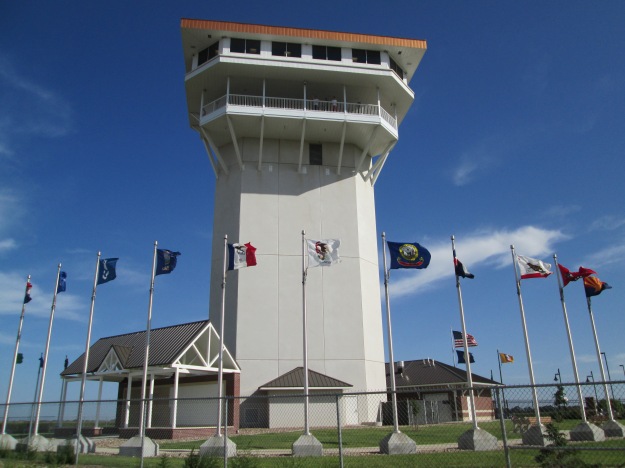
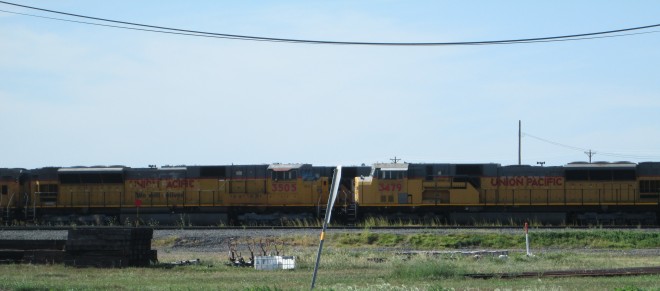
If you’re not interested enough in these particular attractions to fork over the cash to get the insider’s view of them – as I was not, as the above non-panoramic view of the railyard should make plain – you can also visit an original Pony Express station, or Scott’s Bluff Monument, a landmark on the Oregon Trail. But mostly, Nebraska is famous for this, and it’s entirely free to see:
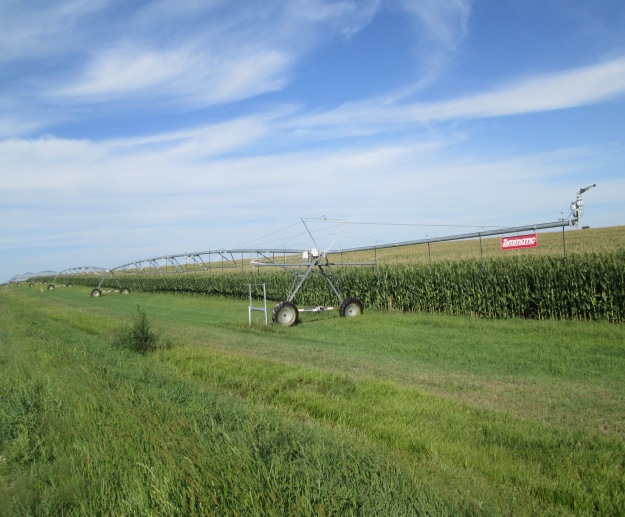
Crops. Acres and acres of crops. And where there are no crops, there are grasslands. Nebraska isn’t as flat as Kansas, as I recall, at least not in the northern part, where hills surround the roads leading north to South Dakota. But even those hills are covered in grass.
It's farm country, the very heart of it, and everywhere you look, you find fields of corn and fields of greens and bales of hay and cattle munching away at the plentiful fields of grass. Nebraska, like Nevada, like Wyoming, has its own unique colors. Green and yellow, yellow and green. They're everywhere: in the grasses, in the haze, in the sunflowers, in the corn. It's a green and yellow world. Golden and glowing, yet green and growing; everywhere growing.
It looks calm, peaceful, harmless. One would never suspect that this gentle-looking land could be subject to such violent outbursts of weather, such as the severe thunderstorm that came upon me yesterday outside of Big Springs.
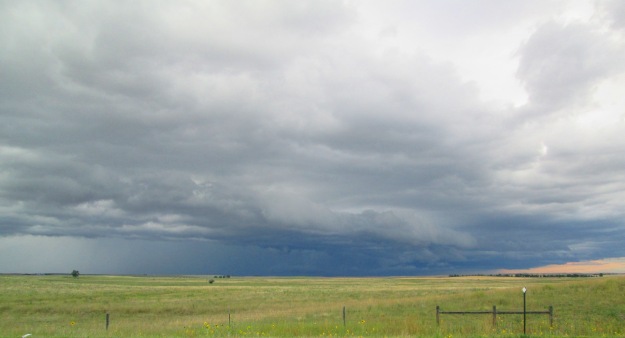
You know it's a bad sign when the National Weather Service breaks in on your radio station to warn you of a thunderstorm of such ferocity that it’s expected to damage vehicles and roofs with its 60 mph winds and quarter-size hail. They weren't kidding about the quarter-size hail. I heard it striking the roof of the motel I had fortunately checked into just twenty minutes before, and then watched as it crashed down just outside my window.
If Nebraska has its characteristic colors, it also has its characteristic sounds. There are two that dominate what you hear when you're out in the countryside: the noises of the irrigation equipment, and the noises of the insects.
The ground seems to be alive with them. The grasshoppers, especially. Also yellow and green, also covering the landscape nearly as completely as the grasses. If you walk upon the grass, you’ll be treated to a flurry of them, jumping up all around your legs, fleeing your unexpected feet. But even these are not nearly so abundant – or annoying – as the flies. All day I've been swatting them away from me. There are so many of them that they managed to permeate my motel room even with the windows closed, as well as the back of my truck, in the few minutes I had it open. I've never seen so many flies, and such determined ones. This, too, is likely characteristic of farm country. Undoubtedly they are drawn by the cows, the widespread manure.
Fortunately, Nebraska's characteristic smell is not that of manure, as it often is in cattle country proper. Rather it is the smell of grass: of growing grass, or freshly mowed grass, or fading, yellowing grass. It's a potent, powerful smell, powerful enough, perhaps, to cover the aroma of cattle, to extinguish the methane gas that's generated by these beasts we love so much to eat, but hate so much to smell.
Nebraska has its charms. Still, I'm looking forward to leaving it, even though I was pleasantly surprised to find something here I have not seen since I last visited the East Coast:

It was not a part of my plan to come here – indeed, I left Wyoming much too soon, and will have to revisit it on my way back. At the last moment something happened to cause me to change my plans, and reroute my trip. But at least I’m headed north again. All along, since I began planning this journey, something's been calling me north; I've yearned to go north. And although I won't be going as far into the wilderness as I had originally hoped, I so long to get closer. Nebraska simply doesn't suit my mood, not this time around.
If my body holds out and my eyes stay open, I will be spending the night in South Dakota. It's one of the places that, often in the last several months, I've longed to be, goodness knows why. Perhaps as I'm wending my way towards Rapid City, I'll remember.
* * *
For more photos and videos from my cross-country travels, please follow my new Pinterest account at http://www.pinterest.com/lorilschafer/ or check out my new YouTube channel here.
For updates on my forthcoming memoir The Long Road Home, which I am drafting during this road trip, please follow my blog or subscribe to my newsletter.
Nebraska doesn't have very many claims to fame. But boy, they sure do try.
In North Platte, you'll find Buffalo Bill Cody's Scouts’ Rest Ranch, where you can watch re-creations of his old Wild West show. Also in North Platte, you'll find the Golden Spike Tower, which offers “a panoramic view of the world’s largest railyard,” the Union Pacific.


If you’re not interested enough in these particular attractions to fork over the cash to get the insider’s view of them – as I was not, as the above non-panoramic view of the railyard should make plain – you can also visit an original Pony Express station, or Scott’s Bluff Monument, a landmark on the Oregon Trail. But mostly, Nebraska is famous for this, and it’s entirely free to see:

Crops. Acres and acres of crops. And where there are no crops, there are grasslands. Nebraska isn’t as flat as Kansas, as I recall, at least not in the northern part, where hills surround the roads leading north to South Dakota. But even those hills are covered in grass.
It's farm country, the very heart of it, and everywhere you look, you find fields of corn and fields of greens and bales of hay and cattle munching away at the plentiful fields of grass. Nebraska, like Nevada, like Wyoming, has its own unique colors. Green and yellow, yellow and green. They're everywhere: in the grasses, in the haze, in the sunflowers, in the corn. It's a green and yellow world. Golden and glowing, yet green and growing; everywhere growing.
It looks calm, peaceful, harmless. One would never suspect that this gentle-looking land could be subject to such violent outbursts of weather, such as the severe thunderstorm that came upon me yesterday outside of Big Springs.

You know it's a bad sign when the National Weather Service breaks in on your radio station to warn you of a thunderstorm of such ferocity that it’s expected to damage vehicles and roofs with its 60 mph winds and quarter-size hail. They weren't kidding about the quarter-size hail. I heard it striking the roof of the motel I had fortunately checked into just twenty minutes before, and then watched as it crashed down just outside my window.
If Nebraska has its characteristic colors, it also has its characteristic sounds. There are two that dominate what you hear when you're out in the countryside: the noises of the irrigation equipment, and the noises of the insects.
The ground seems to be alive with them. The grasshoppers, especially. Also yellow and green, also covering the landscape nearly as completely as the grasses. If you walk upon the grass, you’ll be treated to a flurry of them, jumping up all around your legs, fleeing your unexpected feet. But even these are not nearly so abundant – or annoying – as the flies. All day I've been swatting them away from me. There are so many of them that they managed to permeate my motel room even with the windows closed, as well as the back of my truck, in the few minutes I had it open. I've never seen so many flies, and such determined ones. This, too, is likely characteristic of farm country. Undoubtedly they are drawn by the cows, the widespread manure.
Fortunately, Nebraska's characteristic smell is not that of manure, as it often is in cattle country proper. Rather it is the smell of grass: of growing grass, or freshly mowed grass, or fading, yellowing grass. It's a potent, powerful smell, powerful enough, perhaps, to cover the aroma of cattle, to extinguish the methane gas that's generated by these beasts we love so much to eat, but hate so much to smell.
Nebraska has its charms. Still, I'm looking forward to leaving it, even though I was pleasantly surprised to find something here I have not seen since I last visited the East Coast:

It was not a part of my plan to come here – indeed, I left Wyoming much too soon, and will have to revisit it on my way back. At the last moment something happened to cause me to change my plans, and reroute my trip. But at least I’m headed north again. All along, since I began planning this journey, something's been calling me north; I've yearned to go north. And although I won't be going as far into the wilderness as I had originally hoped, I so long to get closer. Nebraska simply doesn't suit my mood, not this time around.
If my body holds out and my eyes stay open, I will be spending the night in South Dakota. It's one of the places that, often in the last several months, I've longed to be, goodness knows why. Perhaps as I'm wending my way towards Rapid City, I'll remember.
* * *
For updates on my forthcoming memoir The Long Road Home, which I am drafting during this road trip, please follow my blog or subscribe to my newsletter.
Saturday, August 23, 2014
Wyoming - Not Just for Cattle
August 18th, 2014
There are very few people in Wyoming.
I suppose I had always known this; however, the full force of it had never struck me before quite so insistently as it did this time. Perhaps it was more jarring than usual because of the crowded feel of Salt Lake City, or perhaps because, for once, I was not coming from South Dakota or Montana or Iowa, all of which are also comparatively unpopulated states.
I entered Wyoming via a back road, Route 6, which wiggles its way through the mountains in the southwest corner of the state, through miles and miles of empty wilderness.
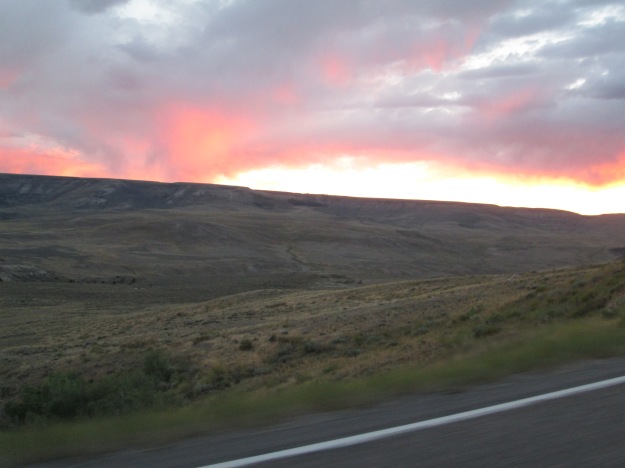
Except, of course, it isn't wilderness. True, there are few people there, but you can tell from the fencing that most of that open space is ranchland, open space for cattle.
This, too, is an amazing drive. Rural highways aren’t built like interstates; they don't refrain from being terrifying. In many spots you find yourself driving along the edge of what seems to be a sheer cliff, the view of which makes you feel as if you're on top of the world. It's a wonderful way of seeing the land.
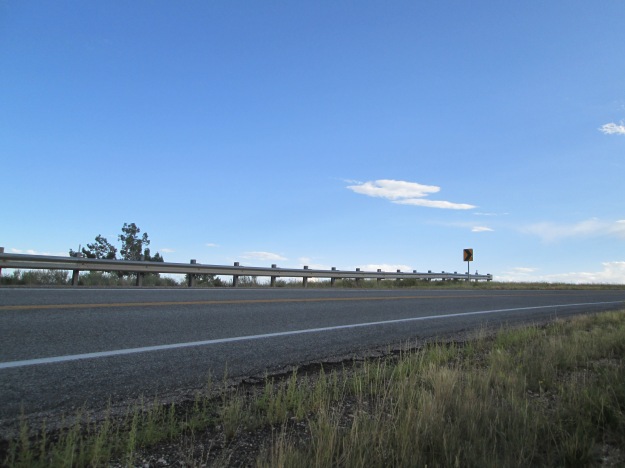
But the interstate, too, has its charms. There aren't too many places in the nation where you can shut down one lane of a two-lane interstate for construction and not create so much as a blip in the traffic.
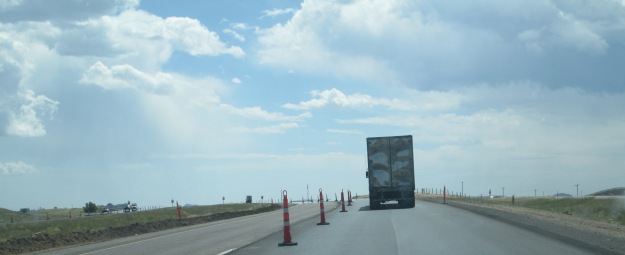
There also aren't too many places left where it's forty miles to the next town, and where it only takes you half an hour to get there, because the speed limit is eighty mph.
The city of Cheyenne, the capital of Wyoming, has a population of roughly 65,000 people. As you drive into town, you see a sign boasting that Cheyenne contains 2300 hotel rooms. To put this in perspective, the Circus Circus in Reno has 1600 hotel rooms. One hotel in one not-so-large city in Nevada, which, is, itself, not one of the most populous states.
Sixty-five thousand people. That is fewer than the number of people who live in my suburb of a suburb of a suburb of a suburb in the Bay Area. It's incredible, and wonderful.
Sometimes I think I'd like to live in a place like this, were it not for the winter weather. I don't even mind the snow very much, as long as I don't have to drive. It seems to me as if you wouldn't want to drive here in the winter, if you could avoid it. At numerous places along Interstate 80, you see signs like this:

Can you imagine what the response would be, if I-80 in the Bay Area (which, for those of you who don't know, is the other end of the same road) was shut down due to weather? Traffic would be backed up for weeks.
It seems a fair trade. Our traffic is backed up daily, if not hourly. Perhaps having your highway closed several times a year is a small price to pay for no rush hour, or, in our case, rush morning, rush evening, and rush afternoon.
Yes, it’s a different experience, being out here where there are probably more cows than people. I was so exhausted that I crashed in a parking area – not a full rest area, but a parking area with no facilities, the kind that truckers use. I suspect that my truck looked rather small, given the company.
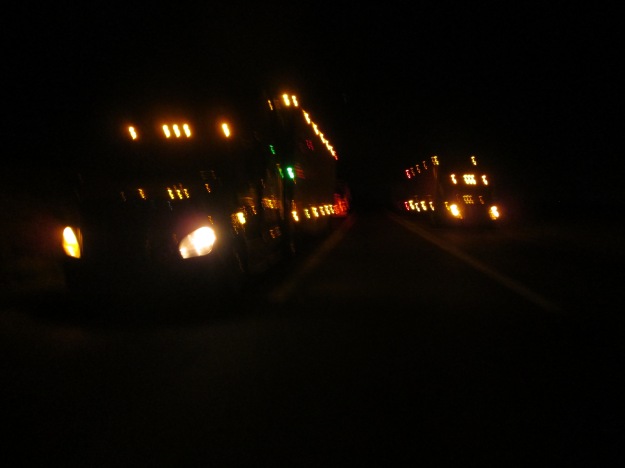
States like Wyoming provide more of these types of amenities, probably because their towns are so few and far between. And in a place like this, away from even the small cities, on a highway unilluminated by any lights but those of the headlights of the occasional trucks passing by, it is so dark, and the sky is so clear and free from smog, that you can see the Milky Way. Do you know how many years it's been since I've seen the Milky Way?
Urban lights are beautiful, too, in their way. There’s nothing quite like gazing down from a hilltop over a vast field of multi-colored city lights, white and yellow and green and red and orange, as if the city itself is some sprawling, highly decorated Christmas tree. Or making a turn on a dark rural highway and spotting the lights of a city in the distance, lights that offer promise, security, human companionship. Those lights beautify the landscape in a different way, in a way that speaks to our most human of instincts, the desire to be with others of our own kind. The lights are a sign, a symbol, an indication that there are more of us waiting just around the bend – they are not merely lights, but welcoming beacons.
Yet in a state like Wyoming, they seem but pale reflections when matched against the glowing, glorious, gigantic field of stars.
If you would like to see more photos from my cross-country travels, please follow my new Pinterest account at http://www.pinterest.com/lorilschafer/.
There are very few people in Wyoming.
I suppose I had always known this; however, the full force of it had never struck me before quite so insistently as it did this time. Perhaps it was more jarring than usual because of the crowded feel of Salt Lake City, or perhaps because, for once, I was not coming from South Dakota or Montana or Iowa, all of which are also comparatively unpopulated states.
I entered Wyoming via a back road, Route 6, which wiggles its way through the mountains in the southwest corner of the state, through miles and miles of empty wilderness.

Except, of course, it isn't wilderness. True, there are few people there, but you can tell from the fencing that most of that open space is ranchland, open space for cattle.
This, too, is an amazing drive. Rural highways aren’t built like interstates; they don't refrain from being terrifying. In many spots you find yourself driving along the edge of what seems to be a sheer cliff, the view of which makes you feel as if you're on top of the world. It's a wonderful way of seeing the land.

But the interstate, too, has its charms. There aren't too many places in the nation where you can shut down one lane of a two-lane interstate for construction and not create so much as a blip in the traffic.

There also aren't too many places left where it's forty miles to the next town, and where it only takes you half an hour to get there, because the speed limit is eighty mph.
The city of Cheyenne, the capital of Wyoming, has a population of roughly 65,000 people. As you drive into town, you see a sign boasting that Cheyenne contains 2300 hotel rooms. To put this in perspective, the Circus Circus in Reno has 1600 hotel rooms. One hotel in one not-so-large city in Nevada, which, is, itself, not one of the most populous states.
Sixty-five thousand people. That is fewer than the number of people who live in my suburb of a suburb of a suburb of a suburb in the Bay Area. It's incredible, and wonderful.
Sometimes I think I'd like to live in a place like this, were it not for the winter weather. I don't even mind the snow very much, as long as I don't have to drive. It seems to me as if you wouldn't want to drive here in the winter, if you could avoid it. At numerous places along Interstate 80, you see signs like this:

Can you imagine what the response would be, if I-80 in the Bay Area (which, for those of you who don't know, is the other end of the same road) was shut down due to weather? Traffic would be backed up for weeks.
It seems a fair trade. Our traffic is backed up daily, if not hourly. Perhaps having your highway closed several times a year is a small price to pay for no rush hour, or, in our case, rush morning, rush evening, and rush afternoon.
Yes, it’s a different experience, being out here where there are probably more cows than people. I was so exhausted that I crashed in a parking area – not a full rest area, but a parking area with no facilities, the kind that truckers use. I suspect that my truck looked rather small, given the company.

States like Wyoming provide more of these types of amenities, probably because their towns are so few and far between. And in a place like this, away from even the small cities, on a highway unilluminated by any lights but those of the headlights of the occasional trucks passing by, it is so dark, and the sky is so clear and free from smog, that you can see the Milky Way. Do you know how many years it's been since I've seen the Milky Way?
Urban lights are beautiful, too, in their way. There’s nothing quite like gazing down from a hilltop over a vast field of multi-colored city lights, white and yellow and green and red and orange, as if the city itself is some sprawling, highly decorated Christmas tree. Or making a turn on a dark rural highway and spotting the lights of a city in the distance, lights that offer promise, security, human companionship. Those lights beautify the landscape in a different way, in a way that speaks to our most human of instincts, the desire to be with others of our own kind. The lights are a sign, a symbol, an indication that there are more of us waiting just around the bend – they are not merely lights, but welcoming beacons.
Yet in a state like Wyoming, they seem but pale reflections when matched against the glowing, glorious, gigantic field of stars.
* * *
For updates on my forthcoming memoir The Long Road Home, which I am drafting during this road trip, please follow my blog or subscribe to my newsletter.
Utah - A Land of Transitions
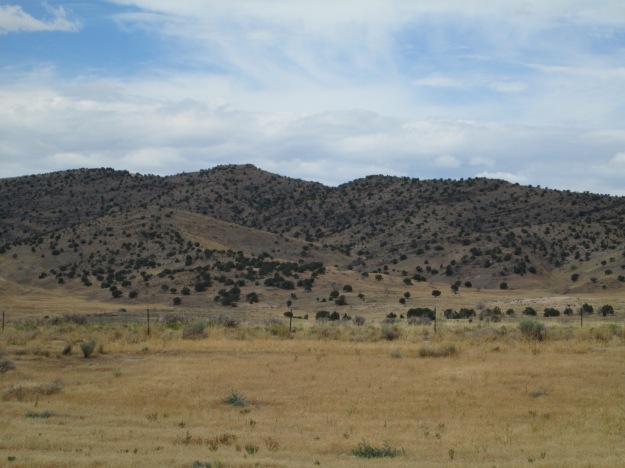
Utah contains landscapes similar to those of many of the states that surround it. Perhaps its most famous area is in the south, where you find all of the fantastic national parks with their brilliantly colored rock formations, which are reminiscent of northern Arizona and New Mexico. But not all of the state is like that. To a large extent, central western Utah resembles Nevada, with its brown hills dotted with shrubs and its wide expanses of desert.
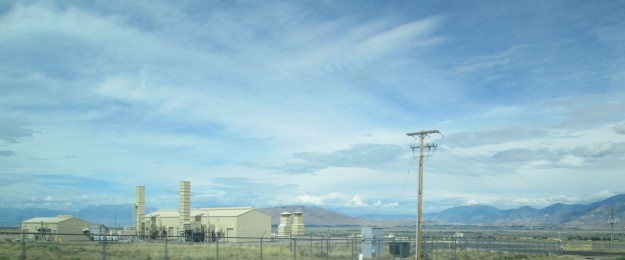
This is pretty far south of the Great Salt Lake area - but even here you can smell the salt in the air. At least here it doesn't get all over your feet and car!
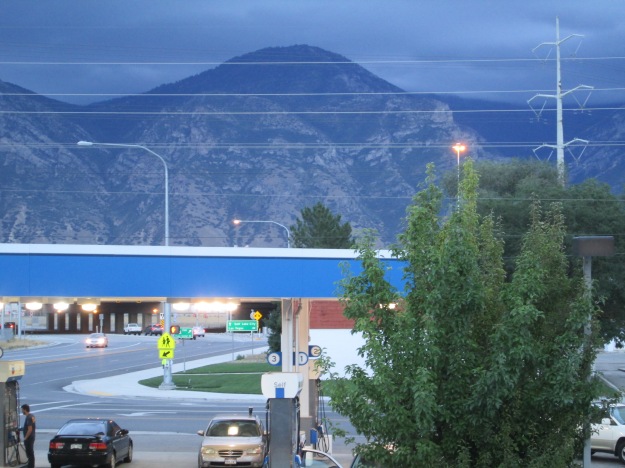
Sunrise comes slowly in the shadows of the mountains surrounding Salt Lake City and its many suburbs. I was surprised by the amount of traffic that now pervades the area - it really seems to have grown in recent years. Not, in my opinion, an improvement.
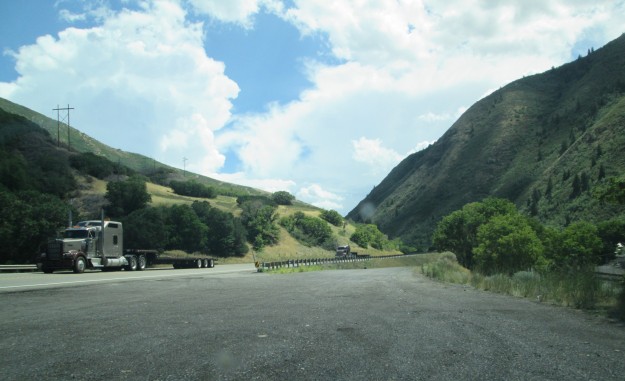
Route 6 east of Salt Lake City - the road leading towards Wyoming, as you can tell by the greener, more tree-filled landscape. There's far more traffic through here than one would imagine. A truck came barreling down the mountain on me so fast it nearly ran me over! Fortunately I realized the driver wasn't going to be able to stop in time, and I took advantage of a nearby pullout to get out of the way.
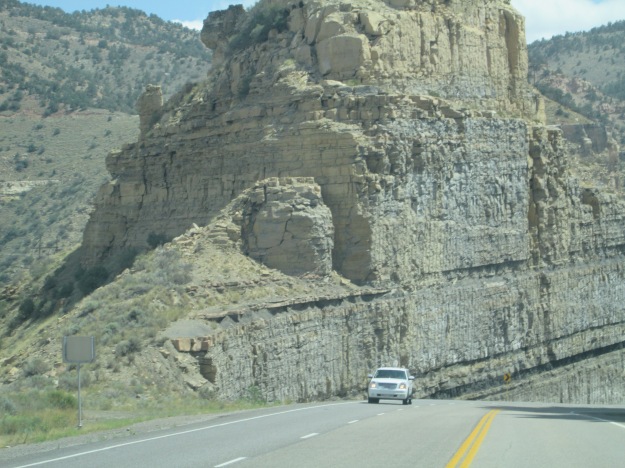
The descent into Price, Utah. Those are some rocks! Perhaps one of the most incredible things about Utah is the way the roads have been built. They did an astonishing job of putting highways in where it seems no highway ought to go. This reminded me of the drive along I-15 from Arizona, where the cliff faces hover so close over the road that they nearly seem to be trying to crowd you off it.
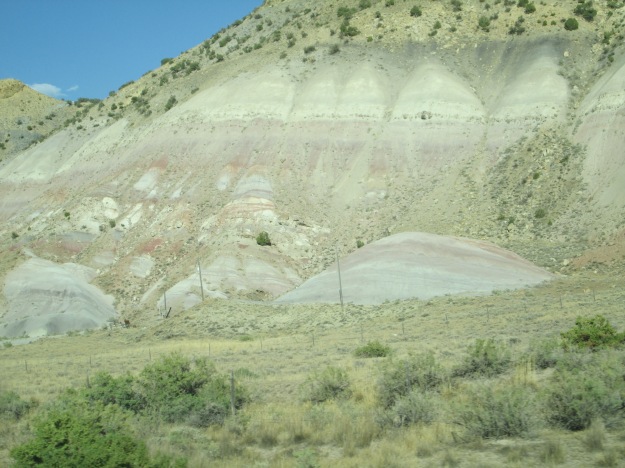
Stratified rock layers in the so-called "Dinosaur Diamond" in the upper northeast corner of Utah near Colorado. All along the highway you see signs identifying the age of the layer of exposed rock and the fossils that can be found there.
***
If you would like to see more photos from my cross-country travels, please follow my new Pinterest account at http://www.pinterest.com/lorilschafer/.For updates on my forthcoming memoir The Long Road Home, which I am drafting during this road trip, please follow my blog or subscribe to my newsletter.
Thursday, August 21, 2014
Dinosaur National Monument - Where Jurassic Park Doesn't Come to Life
August 17, 2014
Today I visited Dinosaur National Monument. It's part of what they call the “Dinosaur Diamond” in the upper northeast corner of Utah and northwest corner of Colorado. This is an area in which a large number of dinosaur fossils have been found, mostly thanks the combination of mountain-building forces and erosion, which led to the exposure of previously buried layers of rock.
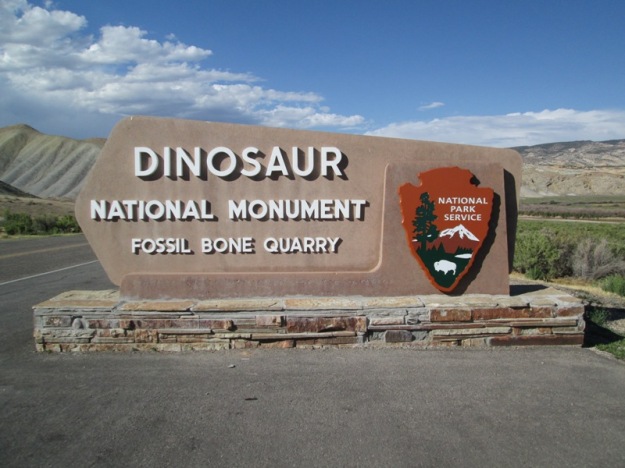
But even for this fossil-filled area, Dinosaur is stunning for the number and variety of dinosaur bones that have been found there. While they do have some reconstructed skeletons on display…
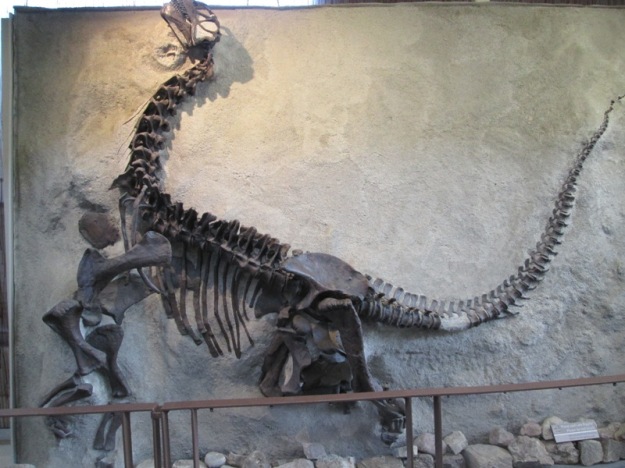
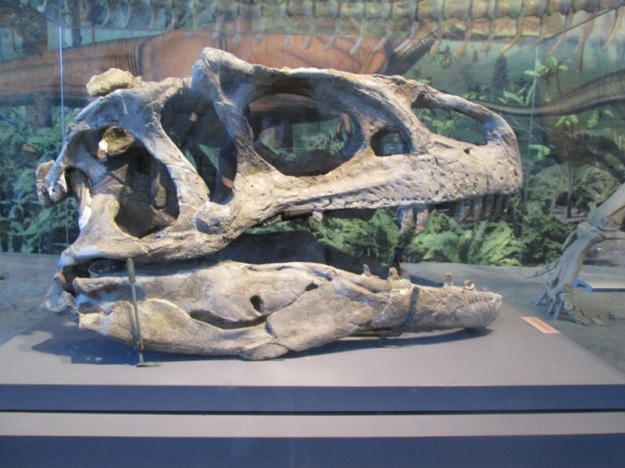
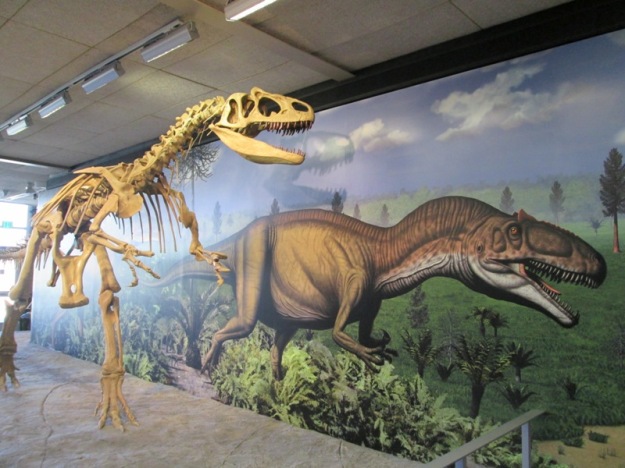
… the main feature of the Quarry Exhibit Hall is a giant wall of rock in which literally hundreds of bones are embedded and clearly visible.
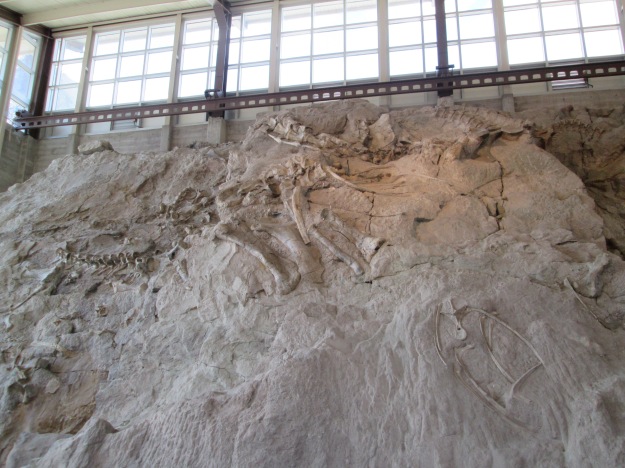

You can even touch the ones you can reach; evidently they aren't harmed by the oil from your fingers, as so many relics are.
There’s a rather sad story behind this amazing paleontological find. Evidently the site used to be a riverbed. During a drought, many dinosaurs died in the area. In the course of subsequent flooding events, their skeletons were covered with mud and sedimentation and eventually fossilized. Later they were exposed by the uplifting of the Uintas Mountains, which caused the rock that had been beneath the ground to be pushed up out of it, leading to paleontologist Earl Douglass’ amazing discovery back in 1909.
You can experience a bit of what Earl Douglass did by taking the Fossil Discovery Trail,
which is an outdoor trail that walks you through various rock formations in which, if you study carefully, you can find exposed fossils! Not as plentiful, and you have to search pretty hard to spot them, because they certainly aren't obvious. Their colors blend perfectly with the rocks, which I guess is a part of the process of fossilization, but if you look closely, you can pick them out, because the shapes of bones are there, and also, they tend to be a bit shinier. It’s tricky, though. I can’t even spot the one I found in this photo – can you?
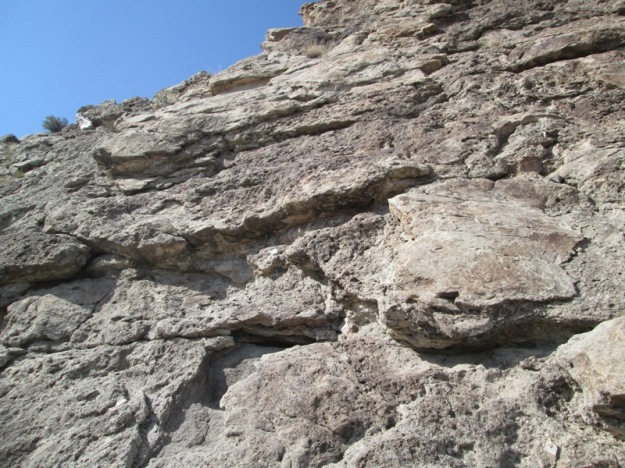
Dinosaur is a very neat place - well worth the visit and the searing desert heat. But I must confess that the rarest fossil I found was actually in nearby Vernal. I mean, dinosaur bones are one thing, but I never dreamed of seeing one of these again:
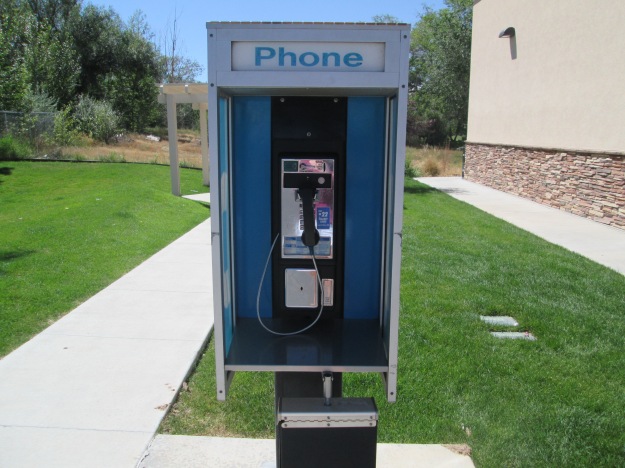
For updates on my forthcoming memoir The Long Road Home, which I am drafting during this road trip, please follow my blog or subscribe to my newsletter.
Today I visited Dinosaur National Monument. It's part of what they call the “Dinosaur Diamond” in the upper northeast corner of Utah and northwest corner of Colorado. This is an area in which a large number of dinosaur fossils have been found, mostly thanks the combination of mountain-building forces and erosion, which led to the exposure of previously buried layers of rock.

But even for this fossil-filled area, Dinosaur is stunning for the number and variety of dinosaur bones that have been found there. While they do have some reconstructed skeletons on display…



… the main feature of the Quarry Exhibit Hall is a giant wall of rock in which literally hundreds of bones are embedded and clearly visible.


You can even touch the ones you can reach; evidently they aren't harmed by the oil from your fingers, as so many relics are.
There’s a rather sad story behind this amazing paleontological find. Evidently the site used to be a riverbed. During a drought, many dinosaurs died in the area. In the course of subsequent flooding events, their skeletons were covered with mud and sedimentation and eventually fossilized. Later they were exposed by the uplifting of the Uintas Mountains, which caused the rock that had been beneath the ground to be pushed up out of it, leading to paleontologist Earl Douglass’ amazing discovery back in 1909.
You can experience a bit of what Earl Douglass did by taking the Fossil Discovery Trail,
which is an outdoor trail that walks you through various rock formations in which, if you study carefully, you can find exposed fossils! Not as plentiful, and you have to search pretty hard to spot them, because they certainly aren't obvious. Their colors blend perfectly with the rocks, which I guess is a part of the process of fossilization, but if you look closely, you can pick them out, because the shapes of bones are there, and also, they tend to be a bit shinier. It’s tricky, though. I can’t even spot the one I found in this photo – can you?

Dinosaur is a very neat place - well worth the visit and the searing desert heat. But I must confess that the rarest fossil I found was actually in nearby Vernal. I mean, dinosaur bones are one thing, but I never dreamed of seeing one of these again:

***
If you would like to see more photos from my cross-country travels, please follow my new Pinterest account at http://www.pinterest.com/lorilschafer/.For updates on my forthcoming memoir The Long Road Home, which I am drafting during this road trip, please follow my blog or subscribe to my newsletter.
Wednesday, August 20, 2014
Arches National Park - Videos
My visit to the amazing Arches National Park near Moab, Utah.
A view of the Windows Arches - and the gloriously full parking lot of people waiting to view them!
If you would like to see more videos from my cross-country travels, please check out my new YouTube channel: https://www.youtube.com/channel/UCb5RugrJMSHh6_4hkgHmkMA.
For updates on my forthcoming memoir The Long Road Home, which I am drafting during this road trip, please follow my blog or subscribe to my newsletter.
If you would like to see more videos from my cross-country travels, please check out my new YouTube channel: https://www.youtube.com/channel/UCb5RugrJMSHh6_4hkgHmkMA.
For updates on my forthcoming memoir The Long Road Home, which I am drafting during this road trip, please follow my blog or subscribe to my newsletter.
Tuesday, August 19, 2014
Living and Working on the Road
What with all the pictures, you might think I'm one of those people who is a fanatic with a camera. Not so. In fact, before my trip to Oxnard last month, I had fewer than fifty photos total of all of my travels from the past twenty years. I had never taken a photo with my phone, and never shot a video with my digital camera. Since when does a phone take pictures? Since when does a photo camera make videos? Why didn't anyone inform me about this?
I guess I'm a bit - by which I mean years - behind the times. These are the first two videos I recorded, and boy, does it show! Not only was I unaware just how shaky "handheld" would be, I also evidently kept forgetting that in video mode, you can't just turn the camera sideways for portrait view. Whoops.
Well, they may not win any Oscars, but in the interest of not messing with my trip record, I decided to leave them as is. The first is an exploration of my new home office - the cab of my truck. The second shows how I've been utilizing voice recognition software to "write" on the road. They may not be pretty, but I hope they're at least informative.
For updates on my forthcoming memoir The Long Road Home, which I am drafting during this road trip, please follow my blog or subscribe to my newsletter.
I guess I'm a bit - by which I mean years - behind the times. These are the first two videos I recorded, and boy, does it show! Not only was I unaware just how shaky "handheld" would be, I also evidently kept forgetting that in video mode, you can't just turn the camera sideways for portrait view. Whoops.
Well, they may not win any Oscars, but in the interest of not messing with my trip record, I decided to leave them as is. The first is an exploration of my new home office - the cab of my truck. The second shows how I've been utilizing voice recognition software to "write" on the road. They may not be pretty, but I hope they're at least informative.
* * *
If you would like to see more videos from my cross-country travels, please check out my new YouTube channel: https://www.youtube.com/channel/UCb5RugrJMSHh6_4hkgHmkMA.For updates on my forthcoming memoir The Long Road Home, which I am drafting during this road trip, please follow my blog or subscribe to my newsletter.
Join Me Under the Arches! Photos from Arches National Park in Utah.
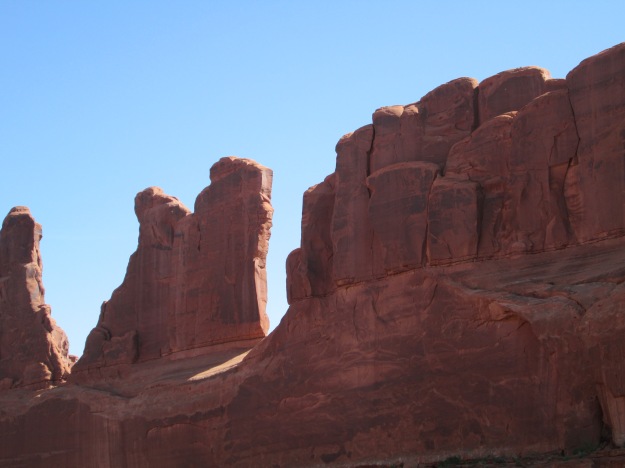
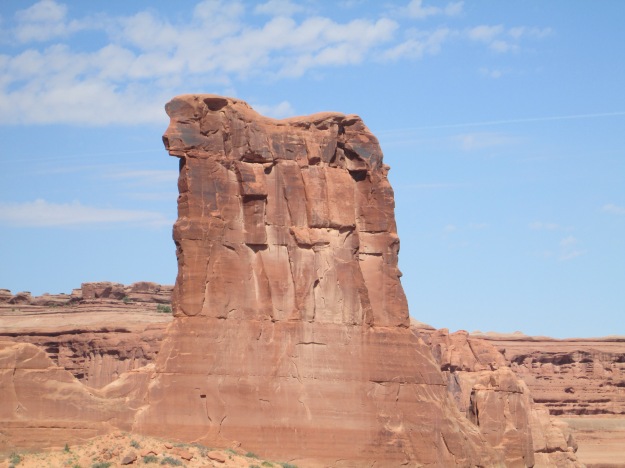
Sheep Rock - Notice the resemblance.
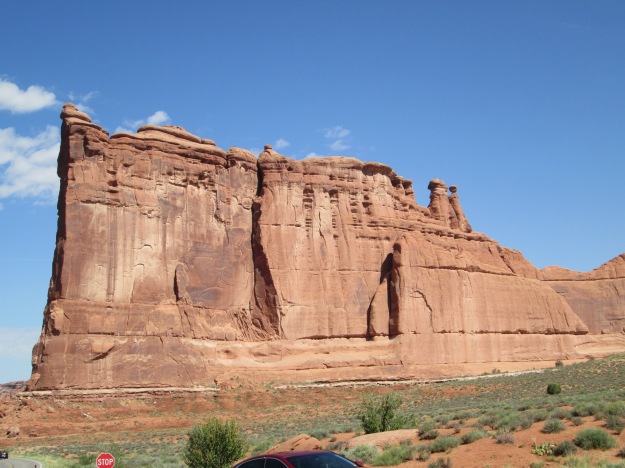
Courthouse Towers.

This one reminds me of the formations in the Valley of the Gods. He sure looks like he's watching over us, doesn't he?
Windows Arch - with people. Lots of people.
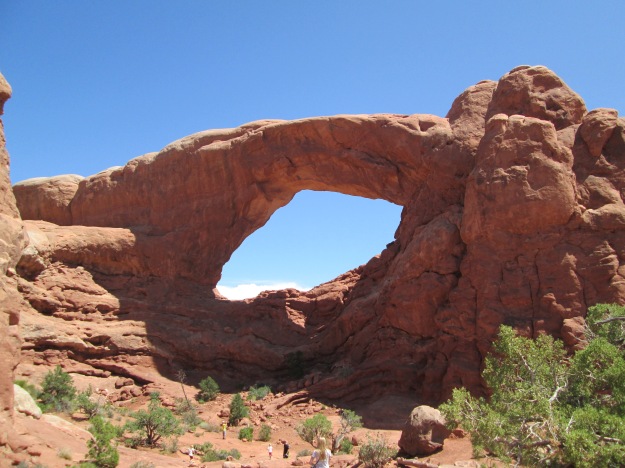
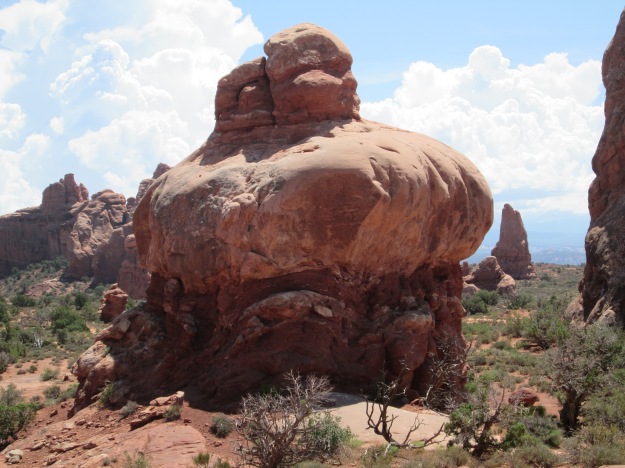
I don't think this one has a name, but I'd call it "Poisonous Mushroom Rock."
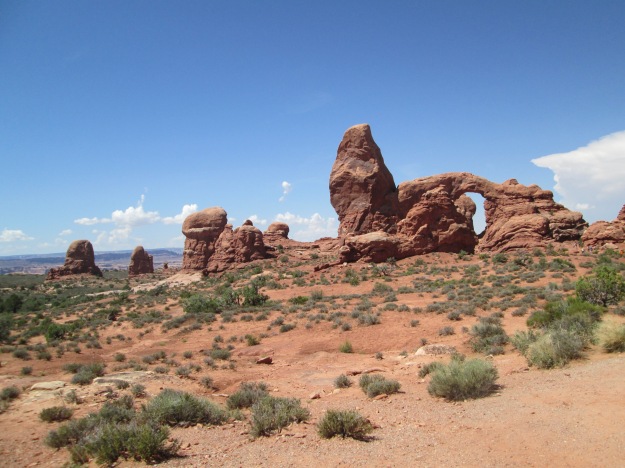
This looks like a playground - best one ever!
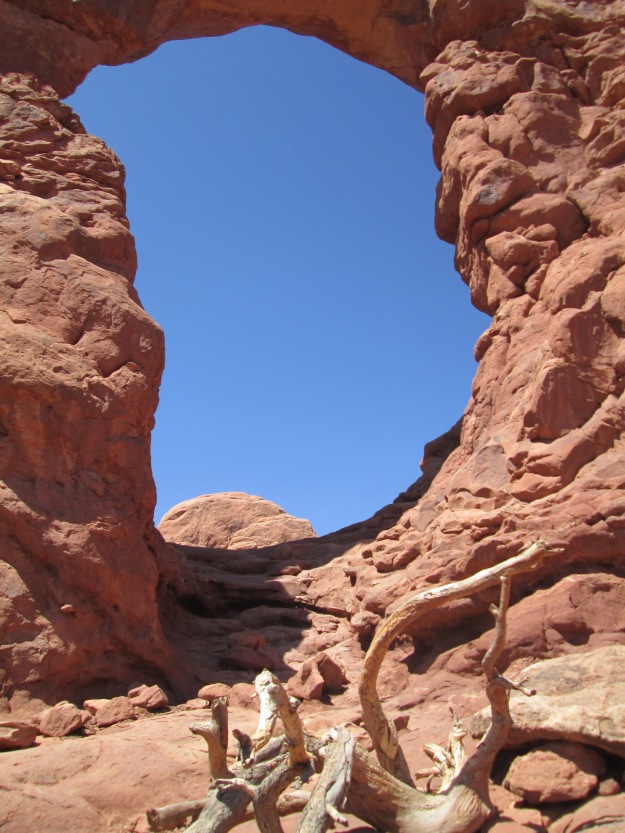
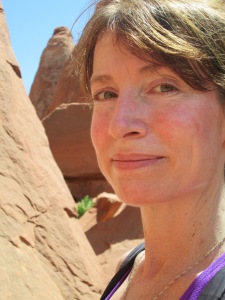
Is is just me, or do I have kind of a Mona Lisa thing going on here?
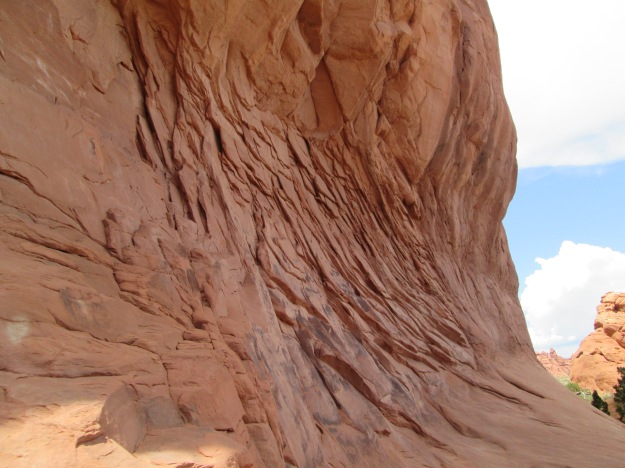
Sometimes it's the striations that make the rock....
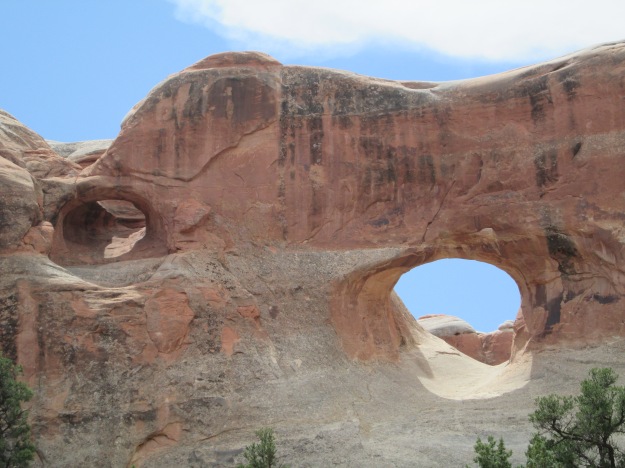
Tunnel Arch(es)
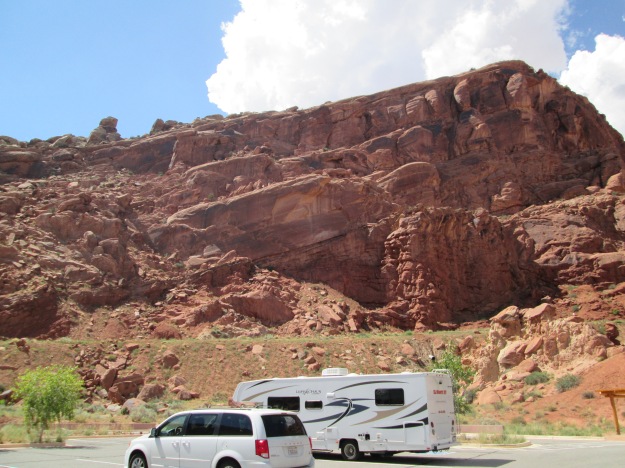
View from the Visitor Center. Makes you want to climb the mountain, doesn't it?
***
If you would like to see more photos from my cross-country travels, please follow my new Pinterest account at http://www.pinterest.com/lorilschafer/.For updates on my forthcoming memoir The Long Road Home, which I am drafting during this road trip, please follow my blog or subscribe to my newsletter.
Sunday, August 17, 2014
Hmmm... Maybe I Don't Need Four Pairs of Shoes.
Needless to say, it takes careful planning to prepare for several weeks of life on the road. As it happens, I drive a pickup truck - a 2011 Ford Ranger - one of the last ones ever made. Why Ford stopped making them, I can't even guess, because it's a great little truck. I bought my first one used back in 1998, and have been driving one ever since. In fact, this is my fourth. That green camper shell you'll see below has been moved twice already! I must say it goes better with the gray than it did with the white.
Anyway, after running away from home in a station wagon - which was not the most comfortable vehicle to live in, although not the worst, either - I learned my lesson and upgraded to larger vehicles. There was, of course, my old '69 Dodge, which will forever remain in my heart as my ultimate favorite (no offense, Ranger!). I loved that van so much that when its drive shaft broke somewhere in Illinois back in 1997, I had one custom-crafted at a machine shop to the tune of a thousand dollars - which was a giant pile of money for me in those days and, in fact, still is.
But alas, the day finally came when the van needed a part that no junkyard in New England could supply, and I had to face facts - the van was dead. I wept without shame when they hauled it away. I still weep when I remember the day.
The Rangers, however, have been great. They're small trucks, so it's no struggle getting in and out of them, no problem parking, and, since I switched to the four-cylinder, the gas mileage is pretty decent, too - 20 to 22 city and up to 30 mpg highway. And you sure couldn't beat the price tag - this one I bought for a mere $13K. Thirteen thousand dollars for a brand new truck! Where are you going to find a price like that anymore? Of course, it's easier when you don't care about the bells and whistles. My windows roll down with a handle. My doors unlock with a key. My steering operates with arm muscles, as does my transmission. I'm all manual, baby!
And although I don't take road trips much anymore, I have found it comforting, these last couple of decades, to own a vehicle that's good for travelling - just in case. And here we are at last - case.
However, somewhere in my memory - my last major road trip was in 2003 - I suppose I must have re-worked my perception of just how much space is really in the back of this truck. Looks plenty roomy, doesn't it?
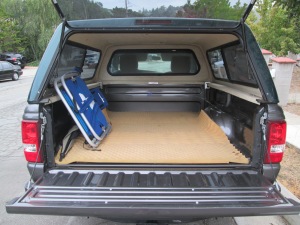
Of course, once you add the microfiber top for me to lie on (somehow my hips are not quite as tolerant of the flatbed as they used to be), and a couple of comforters for the cold nights that will come later in the season, half of that space is gone.
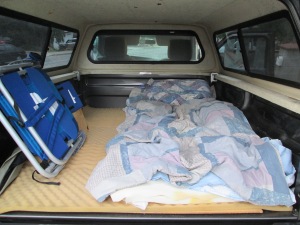
Now back when I was a professional eBay seller specializing in rare and out-of-print videos, and spent months on the road each year buying inventory, I used to actually build the bed on top of video boxes. Really. I assembled a collection of uniformly sized boxes from distributors - they were about 2' by 1', as I recall - filled them with videotapes, and laid down right on top of them. Once I bought so much inventory that I even tried a second layer, but that was a bit claustrophobic for my taste, and I ended up spending my last few nights sleeping in my front seat, which, I confess, truly, truly stunk. Not this time, though, because my passenger seat is packed tight, and this is before I even set up my computer and other equipment:
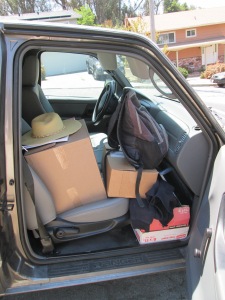
Needless to say, I had to do some re-packing before I could actually lie down that first night in the truck.
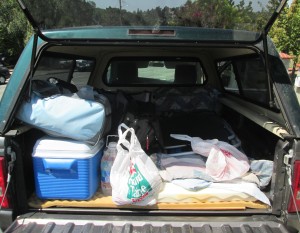
I made it work for that one night, but boy, what a hassle! After a couple of days I realized that while my packing system was very logical - I'd naturally packed "like with like" - it was not really the most efficient use of space. It made far more sense to build the lower layer of my luggage out of stuff I needed less often - such as my spare books and warm clothes - than to insist on keeping them where, in my sense of organization, they "ought" to go. It was with great sadness that I ultimately decided that surface repacking was not going to solve the problem, and instead I ended up emptying the whole truck and starting over. It was hours of work, but I've been much happier with the results, although it is still pretty crowded, as you can see here:
Next time I'll share the view of the cab with all of my modern conveniences assembled around me. Feel free to take a sneak peek via my new YouTube channel here: https://www.youtube.com/channel/UCb5RugrJMSHh6_4hkgHmkMA. Just please don't cry over my less-than-professional cinematography. I'm getting better, I swear!
Anyway, after running away from home in a station wagon - which was not the most comfortable vehicle to live in, although not the worst, either - I learned my lesson and upgraded to larger vehicles. There was, of course, my old '69 Dodge, which will forever remain in my heart as my ultimate favorite (no offense, Ranger!). I loved that van so much that when its drive shaft broke somewhere in Illinois back in 1997, I had one custom-crafted at a machine shop to the tune of a thousand dollars - which was a giant pile of money for me in those days and, in fact, still is.
But alas, the day finally came when the van needed a part that no junkyard in New England could supply, and I had to face facts - the van was dead. I wept without shame when they hauled it away. I still weep when I remember the day.
The Rangers, however, have been great. They're small trucks, so it's no struggle getting in and out of them, no problem parking, and, since I switched to the four-cylinder, the gas mileage is pretty decent, too - 20 to 22 city and up to 30 mpg highway. And you sure couldn't beat the price tag - this one I bought for a mere $13K. Thirteen thousand dollars for a brand new truck! Where are you going to find a price like that anymore? Of course, it's easier when you don't care about the bells and whistles. My windows roll down with a handle. My doors unlock with a key. My steering operates with arm muscles, as does my transmission. I'm all manual, baby!
And although I don't take road trips much anymore, I have found it comforting, these last couple of decades, to own a vehicle that's good for travelling - just in case. And here we are at last - case.
However, somewhere in my memory - my last major road trip was in 2003 - I suppose I must have re-worked my perception of just how much space is really in the back of this truck. Looks plenty roomy, doesn't it?

Of course, once you add the microfiber top for me to lie on (somehow my hips are not quite as tolerant of the flatbed as they used to be), and a couple of comforters for the cold nights that will come later in the season, half of that space is gone.

Now back when I was a professional eBay seller specializing in rare and out-of-print videos, and spent months on the road each year buying inventory, I used to actually build the bed on top of video boxes. Really. I assembled a collection of uniformly sized boxes from distributors - they were about 2' by 1', as I recall - filled them with videotapes, and laid down right on top of them. Once I bought so much inventory that I even tried a second layer, but that was a bit claustrophobic for my taste, and I ended up spending my last few nights sleeping in my front seat, which, I confess, truly, truly stunk. Not this time, though, because my passenger seat is packed tight, and this is before I even set up my computer and other equipment:

Needless to say, I had to do some re-packing before I could actually lie down that first night in the truck.

I made it work for that one night, but boy, what a hassle! After a couple of days I realized that while my packing system was very logical - I'd naturally packed "like with like" - it was not really the most efficient use of space. It made far more sense to build the lower layer of my luggage out of stuff I needed less often - such as my spare books and warm clothes - than to insist on keeping them where, in my sense of organization, they "ought" to go. It was with great sadness that I ultimately decided that surface repacking was not going to solve the problem, and instead I ended up emptying the whole truck and starting over. It was hours of work, but I've been much happier with the results, although it is still pretty crowded, as you can see here:
Next time I'll share the view of the cab with all of my modern conveniences assembled around me. Feel free to take a sneak peek via my new YouTube channel here: https://www.youtube.com/channel/UCb5RugrJMSHh6_4hkgHmkMA. Just please don't cry over my less-than-professional cinematography. I'm getting better, I swear!
Subscribe to:
Posts (Atom)



